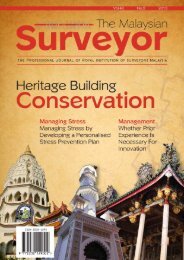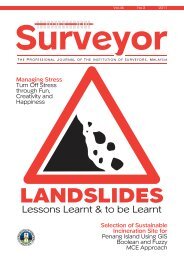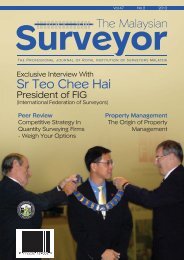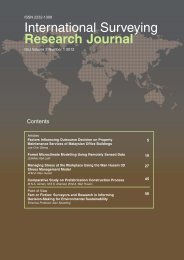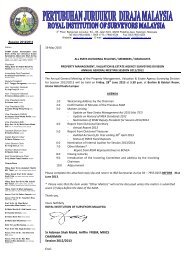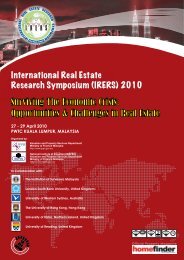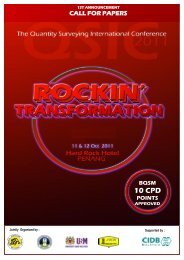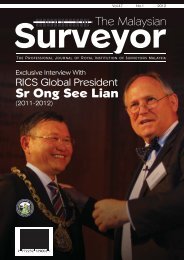Full 46.1 - Royal Institution of Surveyors Malaysia
Full 46.1 - Royal Institution of Surveyors Malaysia
Full 46.1 - Royal Institution of Surveyors Malaysia
You also want an ePaper? Increase the reach of your titles
YUMPU automatically turns print PDFs into web optimized ePapers that Google loves.
THE MALAYSIAN SURVEYOR | Vol.46 | No.1 | 2011<br />
Building conservation is an increasingly important concept in today’s fast-developing era. The<br />
word “conservation” alone refers to the guardianship <strong>of</strong> buildings from being lost, wasted,<br />
damaged or destroyed. However, conservation generates multiple issues in its work making it<br />
difficult and unfavourable. This paper explores the issues faced in <strong>Malaysia</strong>’s first conservation<br />
project <strong>of</strong> the Syed Alatas Mansion. The case study <strong>of</strong> the Syed Alatas Mansion is conducted via<br />
an interview session with the Assistant Manager and reference to documentary sources. The<br />
research has identified three categories <strong>of</strong> major issues in the conservation <strong>of</strong> the Syed Alatas<br />
Mansion i.e. technical, organisational and economic issues that has been described in detail. This<br />
research has put forward some recommendations to remedy the described situation.<br />
whilst the building<br />
remained a store<br />
and dormitory for<br />
the Chettiar bottle<br />
recyclers for almost<br />
fifty years. Used for<br />
shelter and security,<br />
the original fabric<br />
was virtually intact,<br />
although in need <strong>of</strong><br />
repair.<br />
Pic 1: The front view <strong>of</strong> the Syed Alatas Mansion<br />
1.0 Introduction<br />
The Syed Alatas Mansion, located on<br />
Armenian Street, Penang was proposed as a case<br />
study in order to exemplify conservation issues<br />
faced in real projects that have taken place and<br />
demonstrate best practice conservation techniques. It was<br />
intended that the knowledge gained could serve to<br />
expand the expertise <strong>of</strong> the local building industry and<br />
encourage further conservation projects. The realities <strong>of</strong><br />
cultural heritage as a form <strong>of</strong> cultural identity are never<br />
more apparent than during the process <strong>of</strong> conservation<br />
projects. Thus, in order to depict the kinds <strong>of</strong> issues<br />
involved in conservation projects as per said in the<br />
literature and reinstated by the feedbacks from<br />
questionnaire survey, a case study is examined. The case<br />
study demonstrates how these issues come into play in<br />
the real industrial scenario. For those without experience<br />
in seeing beyond the dereliction and problems decay, to<br />
the possibilities conservation can <strong>of</strong>fer, the only time in<br />
the course <strong>of</strong> a project when the attention is caught and<br />
the inexperienced observers can begin to imagine a<br />
building’s potential is when the project is almost<br />
complete. It is at this stage when identity tussles are<br />
active. During this process, many issues are faced which<br />
significantly affects the performance <strong>of</strong> the conservation<br />
project. These issues are assembled and analysed.<br />
2.0 Historic Background<br />
The late nineteenth century Anglo-Indian had been<br />
acquired by the MPPP for road-widening land, after World<br />
War Two. By 1993, nothing had subsequently taken place<br />
The “tenants” were<br />
easily persuaded to<br />
leave, joining the<br />
remaining Indian<br />
recycling community,<br />
which occupied<br />
Pic 2: Restored stairs <strong>of</strong> the Syed Alas Mansion<br />
many <strong>of</strong> the<br />
premises adjacent to<br />
the Mansion. At that time in 1993, rent-controlled<br />
accommodation was available in this area. However,<br />
cultural tourism, represented by the soon-to-be-gentrified<br />
Mansion was thought to need a more sanitised<br />
environment and the Chettiars are now threatened with<br />
relocation away from the “tourist gaze” (Khoo and<br />
Jenkins, 2002; 215).<br />
In 1993, the MPPP took possession <strong>of</strong> the building for the<br />
Syed Alatas Mansion Heritage Development Project. After<br />
many delays, the restoration took place funded by the<br />
Federal, state and MPPP governments. A Penang<br />
architect, in consultation with the French team <strong>of</strong><br />
architects and craftsmen supervised a local contractor<br />
who had expressed an interest in conservation practice.<br />
The enthusiasm created by the project was endorsed by<br />
the Prime Minister then, who, during his visit on the 20th<br />
<strong>of</strong> December 1993, signed the plaster rose installed on<br />
the gable <strong>of</strong> the Porte cochere. The then Honorary<br />
Secretary <strong>of</strong> the Penang Heritage Trust, who was<br />
appointed project manager for the site, saw the project as<br />
the beginning <strong>of</strong> a new trend in heritage development.<br />
In 1999, the “French” restoration <strong>of</strong> the mansion won the<br />
Badan Warisan <strong>Malaysia</strong>’s award for The Most Excellent<br />
Project in recognition <strong>of</strong> its conservation quality and<br />
potential in encouraging other conservation projects. The<br />
26



